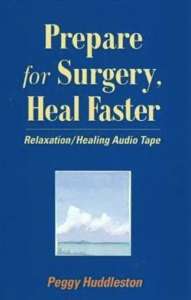

After years of misdiagnosis of vague yet troubling symptoms, I found out that I needed surgery for a huge mass invading my entire abdominal cavity. I was in shock and called my friend Daniel, who canceled his plans and came to sit with me and help me get calm. “You are strong. You will get through this, you must,” he said as we drank chilled white wine together.
It was the first of many encouraging conversations but, despite Daniel’s incredible support and the equally amazing support from family, friends and my zen meditation group, I still felt disoriented with what I was facing. I was overwhelmed as I chose a surgeon, prepared for surgery, went to the hospital, and endured a painful recovery.
For me, and for countless others, Prepare for Surgery, Heal Faster, has helped to rewire the frightening ordeal of surgery into a path with the potential for total healing and deep renewal.
Peggy Huddleston is a psychotherapist and graduate of Harvard Divinity School. Her comprehensive mind-body approach to preparing for, undergoing, and healing from surgery is a five-step method that maps the labyrinth the surgical world can be. These steps include:
1. Calm your mind and body before, during, and after the operation by the use of a specific guided relaxation CD (included with the book) that helps to create peaceful feelings that contribute to strengthening the immune system and the body’s overall functioning.
2. Visualize your recovery and create healing imagery and goals that can propel you to that healed state.
3. Surround yourself with the love and support of family and friends—support that can aid in the healing process and give you a better surgical outcome.
4. Create healing statements to be read to you before, during, and after the operation that send a post-hypnotic type of message to your deeper mind. These healing statements include specific ones for creating physiological responses that can foster quicker healing, and statements of personal meaning for the individual that bring spiritual and emotional depth to the recovery period.
5. Learn to forge interactive, respectful relationships between yourself and the medical community.
Huddleston’s method worked remarkably well. I went into my next two surgeries less anxious and more prepared, and after both, needed smaller amounts of pain medicine than in the first surgery. I felt more balanced and not in as much shock.
The use of the healing statements and the guided relaxation CD became a practice akin to sitting zen meditation (or Metta or Tonglen practice), and brought to the surface the deep connection of healing with the spiritual in life. In creating my personal healing statements, I found myself confronted with what zen refers to as “The Great Matter,” the teeming vibrancy of life itself, and as I composed each one I could hear Daniel’s voice saying, “You will get through this, you must.”



